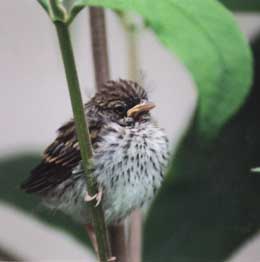
The Garden Club of Brockport, at its last meeting in the historic Morgan Manning House, enjoyed a slide-presentation about English cottage gardening given by Mark Dunham, a local gardener and landscape designer. Dunham, of Hamlin, is a member of the garden club, and is one of those fortunate souls who found a way to combine his passion in life with the way he earns his living. The cottage garden style just comes naturally to him, a jumble of plants set cheek-to-jowl, in a hodgepodge of textures, heights, colors and fragrances just outside the door of a typical peasant’s cottage. Traditionally the gardens kept by tenants or small landowners were both modest and convenient. Just a quick step outdoors and one could pluck a cabbage for dinner or a few sprigs of a medicinal herb. Plants were acquired from family, friends and neighbors, so cottage gardens tended to look alike, even in Canada and the United States, as seeds or cuttings were brought along by new immigrants. As the pioneers of America moved across the frontier, they frequently took a cutting of this and that from Grandma’s garden along with them, making cottage gardens of the Genesee (and elsewhere) look almost identical to those of Connecticut or the other places from which settlers came. In his slide presentation about cottage gardening, Dunham explained how he established and maintains his garden, emphasizing certain flowers and plants that have, for him, sentimental meaning. He remembers, for instance, the red poppies and peonies in his mother’s garden when he was a small boy.
Cottage gardening, by its nature, requires a minimum of work. With plants grouped so close together, few weeds find room to take hold; heavy mulching keeps weeds away as well as minimizing the amount of watering needed. Dunham’s cottage garden in Hamlin is just a year old, although it looks like it could be decades older. He uses found objects to add character to the garden, including a table and chairs with an overhanging candelabra, distinctive rocks and interesting wood and metal objects. A special spot in a corner of the garden is the wooden bench where he starts his day with meditation and coffee. Dunham’s landscape and garden business is named "Back To Eden." He says he came up with that name so he would be able to say, at the end of his work day, "It’s time to go Back To Eden." For more information about cottage gardening Dunham recommends two books he read to get started: Creating a Cottage Garden in North America, by Steven Westcott Gratton, published by Raincoast Books, 800 663-5714, and Making a Cottage Garden by Faith and Geoff Whiten. For additional information, including typical cottage garden plants and flowers, log on to: http://butterflywebsite.com/articles/bgq/CottageGarden.htm Notes:
Mark Dunham’s cottage garden in Hamlin was designed with wildlife in mind. To attract butterflies he chose an open sunny area with a southern exposure, buffered by a fence and shrubs to protect the butterflies from strong westerly winds. Because different butterflies travel at different levels, Mark placed plants of different heights throughout his garden. Where possible, he places tall plants in the back, medium height plants in the middle and low-growing plants in front and along the paths. Cottage garden style and designing a garden to attract butterflies are nearly identical endeavors, so selecting plants for pleasing color (to humans) and attractiveness to butterflies is a win-win situation. Dunham favors monarda (bee balm), purple coneflower, aster, cosmos, liatris, dianthus, black-eyed Susan, marigold, coreopsis, scabiosa, and zinnia. Butterflies are also attracted to certain herbs, like bronze fennel, dill, and catmint. Joe Pye weed, a native species with a lovely flat pink blossom, is a butterfly magnet. Flowering shrubs, like the aptly named butterfly bush (buddleia), and lilacs are ideal both for their nourishing nectar and as garden wind screens. Dunham also recommends:
Once established, identify the kinds of butterflies that inhabit your garden and then sow those plants which will serve as a host for caterpillars. Milkweed, for instance, is the "nursery" for monarch butterflies. For more information about identifying butterflies, and butterfly gardening go to: The North American Butterfly Association, www.naba.org or www.butterflywebsite.com. |



